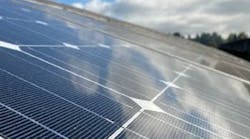Executives with Portland General Electric Co. will this week let the Oregon Public Utilities Commission know which bidders have made the shortlist for its large renewable energy and non-emitting capacity resources program.
As part of its first-quarter earnings report, the Oregon-based utility said April 28 that the shortlist includes seven proposals for renewables and another six for capacity projects, with the bidders still confidential at this point. President and CEO Maria Pope and CFO Jim Ajello told analysts and investors on a conference call that they are looking to start negotiating with bidders this summer as OPUC gives them the nod and hope to conclude contracts by year’s end.
PGE leaders last fall outlined their plans to ramp up their portfolio of renewable and non-emitting assets by up to 500MW and 375MW, respectively. Ajello on April 28 said the shortlisted bids, which included some project PGE itself would undertake, together represent about 8,000MW of renewable power and 3,000MW of capacity resources, although there’s some overlap among the individual bids.
“Considering the environment that we’re in, there’s a lot of fluidity here,” Ajello said. “There’s a great deal of oversubscription and a great deal of permutations. So we go into this process in the second half of the year with some opportunity for folks to come forward. But there also may be some scenarios where some drop out.”
There’s a good chance PGE—and its peers preparing similar investment pushes—will need to have those multiple options available and a flexible timeline. A solar industry manufacturing supply chain that already had been strained has been further complicated in recent weeks by the U.S. Department of Commerce’s decision to investigate a California company’s claim that panels imported from four Southeast Asian nations are circumventing tariffs the United States imposed on Chinese manufacturers a decade ago. That has led to some suppliers sitting on product while they wait for Commerce’s initial findings, which are expected in August.
Ajello said it’s possible some of PGE’s solar plans end up being delayed or changed because of the state of the market, the need for OPUC approval and the ability of bidders to stick to the prices they’ve quoted in their initial proposals.
“There’s enough time toward the end of ’24 to get these projects in service,” Ajello said, adding that the big picture around PGE’s investments in the coming decade haven’t changed and that other RFPs will follow this one. “But bottom line, it’s too hard to call right now. We’re just early on in the process […] There’s a lot of uncertainty. I really want to stress that.”
While the RFP was a major area of focus for Pope and Ajello on PGE’s conference call, the duo also discussed the recent OPUC rate case order that included elements that have led them to lower PGE’s past deferrals related to wildlife restoration and COVID-19 and to cut their earnings-per-share forecast for the year to $2.50 to $2.65 from $2.75 to $2.90. Combined with ongoing increases in the cost of labor and materials—factors Pope said she thinks will stick around “for quite a while”—the PGE team is sharpening its focus on operating expenses to be more “in line with the realities of our commission’s cost expectations.”
PGE produced a first-quarter net profit of $60 million on total revenues of $626 million compared to $96 million and $609 million, respectively, in the year-ago period. Purchased power and fuel was a major factor in that drop, rising to $202 million from $169 million in early 2021.
Shares of PGE (Ticker: POR) fell more than 4% to $49.36 April 28. They are now down about 6% year to date.


